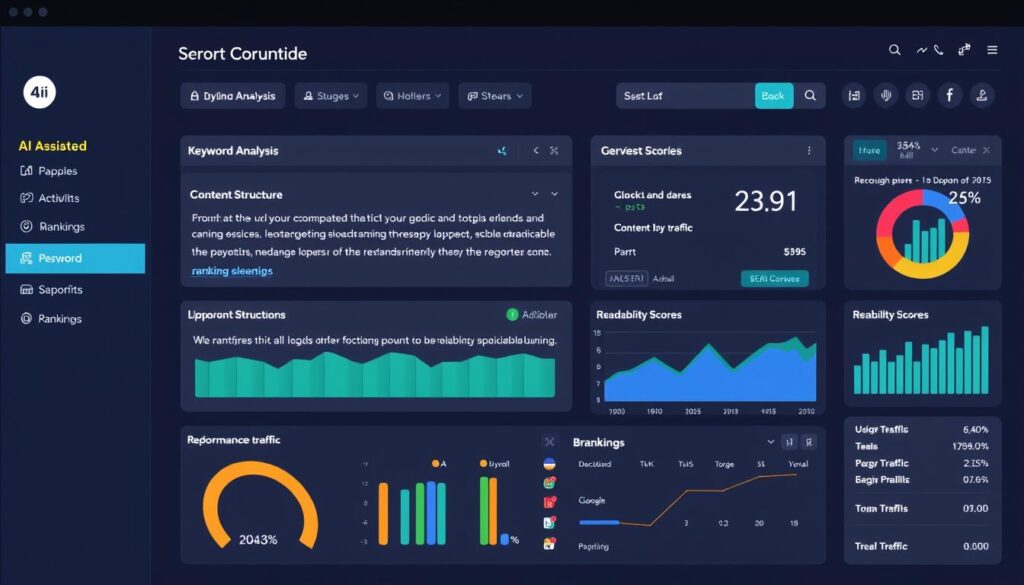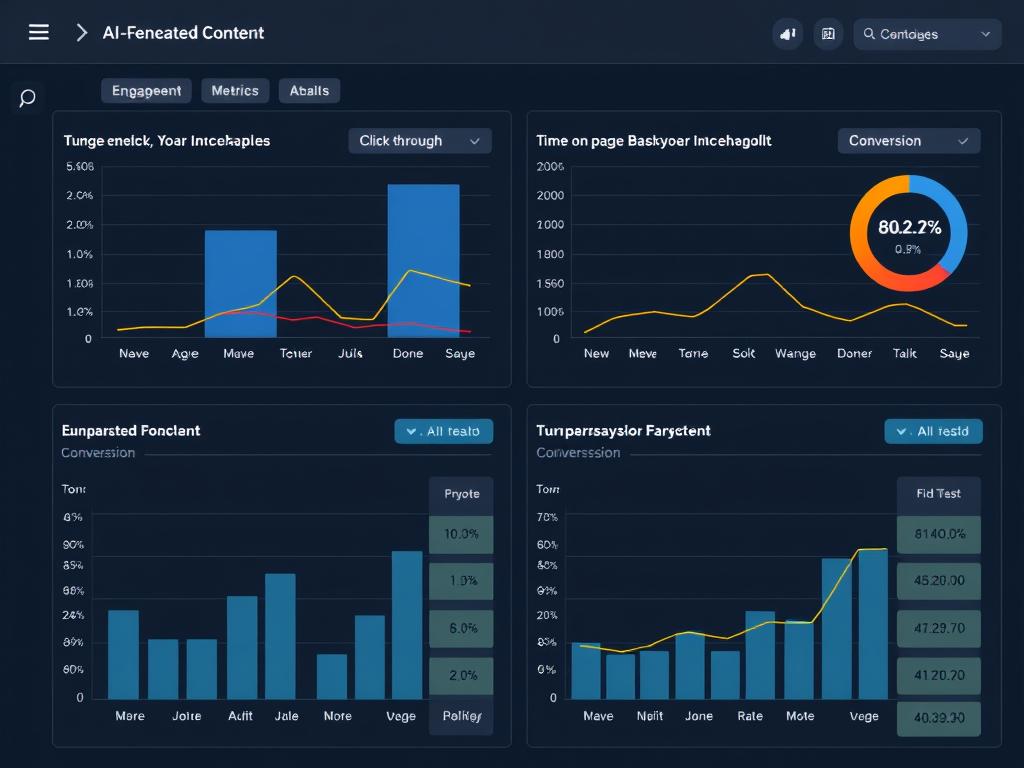Creating consistent, high-quality content has become a never-ending challenge for bloggers, social media managers, and digital marketers. The pressure to publish regularly across multiple platforms while maintaining quality can be overwhelming. This is where AI content creation tools are changing the game, offering a way to work smarter rather than harder.
Whether you’re struggling with writer’s block, drowning in content requests, or simply looking to scale your output without sacrificing quality, AI tools can be your secret weapon. In this guide, we’ll explore how these innovative technologies can transform your content creation process, helping you produce more while reclaiming valuable time.
The AI Revolution in Content Creation
AI tools are transforming how content creators work, enabling faster production across multiple formats
The content creation landscape has undergone a dramatic transformation in recent years. What once required hours of brainstorming, research, writing, and editing can now be streamlined with AI assistance. According to recent studies, over 60% of marketers have already integrated AI tools into their workflow to generate content more efficiently.
These tools aren’t replacing human creativity—they’re enhancing it. By handling routine tasks and providing creative suggestions, AI allows you to focus on strategy, refinement, and the uniquely human aspects of content creation that truly connect with your audience.
The benefits extend beyond just saving time. Content creators using AI tools report:
- Increased content output by 2-3x without additional resources
- More consistent publishing schedules across platforms
- Reduced creative burnout and writer’s block
- Ability to experiment with more content formats and topics
- Improved content performance through data-driven optimization
As we explore the specific tools and strategies in this guide, remember that AI works best as a collaborative partner in your creative process—not a replacement for your unique voice and expertise.
Key AI Content Creation Tools to Transform Your Workflow
With dozens of AI tools on the market, finding the right ones for your specific needs can be challenging. We’ve tested and selected the most effective AI content creation tools that deliver real results for bloggers, social media managers, and digital marketers.

Modern AI content creation tools offer intuitive interfaces and powerful features for various content needs
1. Jasper (Formerly Jarvis)
Best for: Long-form content, blog posts, marketing copy, and versatile content generation
Jasper is one of the most comprehensive AI writing assistants available, capable of generating everything from short social media captions to full-length blog articles. What sets Jasper apart is its ability to maintain consistent tone and style throughout longer pieces—something many AI tools struggle with.
The platform offers over 50 templates for specific content types, including blog posts, product descriptions, emails, and ad copy. Its “Boss Mode” allows for more control over the AI, enabling you to give it more detailed instructions and have it remember more context from your previous inputs.
Key features:
- Long-form assistant for blog posts and articles
- SEO integration with Surfer SEO
- Brand voice customization
- Content improver for rewriting and enhancing existing content
- Multilingual support (25+ languages)
Real user feedback: “Jasper has cut my content creation time in half. What used to take me 4 hours to write now takes about 90 minutes, including all edits and refinements.”
2. Copy.ai
Best for: Social media content, email marketing, ad copy, and quick content generation
Copy.ai excels at creating short-form content with a natural, engaging tone. Its intuitive interface makes it accessible even for those new to AI tools, while its extensive template library helps you quickly generate specific types of content.
The platform is particularly strong for social media managers who need to create content across multiple platforms. Its ability to generate variations of the same core message tailored to different platforms (LinkedIn, Twitter, Instagram, etc.) is a significant time-saver.
Key features:
- 90+ templates for different content formats
- Blog post wizard and outline generator
- Digital ad copy for various platforms
- Email subject line and body generators
- Content repurposing across platforms
Real user feedback: “Copy.ai helps me batch create a month’s worth of social media content in just one afternoon. The variations feature ensures I’m not posting the exact same message everywhere.”
3. ChatGPT
Best for: Versatile content assistance, brainstorming, outlining, and research
While not specifically designed for content creation, ChatGPT has become an essential tool for many content creators. Its flexibility and ability to understand complex prompts make it valuable for brainstorming ideas, creating outlines, generating headlines, and even drafting sections of content.
The free version provides access to GPT-3.5, which is sufficient for many content tasks. For more advanced capabilities, GPT-4 (available with ChatGPT Plus) offers improved reasoning, creativity, and longer context windows—allowing it to understand and generate more sophisticated content.
Key features:
- Content ideation and brainstorming
- Outline generation for articles and posts
- Headline and title suggestions
- Content repurposing and summarization
- Research assistance and information gathering
Real user feedback: “I use ChatGPT as my initial brainstorming partner. When I’m stuck, a 10-minute conversation with it usually gives me enough ideas and direction to get moving again.”
4. Canva Magic Write
Best for: Visual content creation, presentations, social media graphics with text
Canva’s Magic Write feature brings AI writing capabilities to the popular design platform, creating a powerful combination for content creators who need both text and visuals. This integration allows you to generate written content directly within your design projects.
For social media managers and marketers who regularly create visual content, this tool eliminates the need to switch between multiple platforms. You can generate copy, design the visual, and prepare it for publishing—all in one place.
Key features:
- AI text generation within design projects
- Social media caption generation
- Headline and copy suggestions for graphics
- Content ideation integrated with visual design
- Seamless workflow between text and visual elements
Real user feedback: “Magic Write has streamlined my Instagram workflow completely. I can create the visual and generate the caption all in one place, saving me at least an hour of work daily.”
5. OwlyWriter AI
Best for: Social media content, platform-specific posts, and content repurposing
OwlyWriter AI, developed by Hootsuite, is specifically designed for social media content creation. What makes it stand out is its understanding of different social platforms’ unique requirements and audience expectations.
The tool can generate platform-optimized content based on your prompts, repurpose existing content for different networks, and even suggest content ideas based on trending topics in your industry. For social media managers handling multiple accounts across different platforms, OwlyWriter can be a significant time-saver.
Key features:
- Platform-specific content generation
- Caption generation from links or prompts
- Content repurposing across platforms
- Hashtag suggestions and optimization
- Integration with Hootsuite’s scheduling tools
Real user feedback: “OwlyWriter understands the nuances between platforms better than any other tool I’ve tried. The content it creates for LinkedIn feels professional, while Instagram captions are more casual and engaging.”
6. Midjourney
Best for: AI image generation, visual content, and creative illustrations
While many AI tools focus on text, Midjourney specializes in generating stunning visual content from text prompts. For content creators who need unique images for blogs, social media, or marketing materials, Midjourney offers a way to create custom visuals without graphic design skills.
The quality of Midjourney’s outputs has improved dramatically, with many images being virtually indistinguishable from professional photography or artwork. This makes it an invaluable tool for creating eye-catching featured images, social media graphics, and illustrations that complement your written content.
Key features:
- High-quality image generation from text prompts
- Various artistic styles and aesthetic options
- Custom aspect ratios for different platforms
- Ability to iterate and refine generated images
- Commercial usage rights (with paid plans)
Real user feedback: “Midjourney has eliminated our need for stock photos. We can create exactly the images we need for our content, saving us hundreds of dollars monthly on photo subscriptions.”
7. Buffer AI Assistant
Best for: Social media content, scheduling, and analytics
Buffer’s AI Assistant combines content creation with scheduling and analytics, offering a comprehensive solution for social media management. The tool can generate platform-specific content, suggest optimal posting times, and help you analyze performance to refine your strategy.
What makes Buffer’s AI Assistant particularly valuable is its integration with Buffer’s scheduling and analytics tools. This creates a seamless workflow from content creation to publishing and performance tracking, all within a single platform.
Key features:
- AI-powered content generation for social media
- Platform-specific formatting and optimization
- Content repurposing and idea generation
- Integration with scheduling and analytics
- Hashtag suggestions and engagement optimization
Real user feedback: “Buffer’s AI Assistant has streamlined our entire social media workflow. We can generate, schedule, and analyze content all in one place, saving us hours each week.”
| Tool | Best For | Key Feature | Free Plan | Starting Price |
| Jasper | Long-form content, blogs | Boss Mode for extended context | 7-day trial | $49/month |
| Copy.ai | Short-form, social media | 90+ templates | Yes (limited) | $49/month |
| ChatGPT | Versatile assistance | Flexible conversation format | Yes | $20/month (Plus) |
| Canva Magic Write | Visual content with text | Integrated with design tools | Yes (limited) | $12.99/month |
| OwlyWriter AI | Social media content | Platform-specific optimization | Limited features | Part of Hootsuite plans |
| Midjourney | Image generation | High-quality visuals | Limited trial | $10/month |
| Buffer AI Assistant | Social media management | Integrated scheduling | Yes (limited) | Included with Buffer |
Time-Saving Strategies with AI Content Creation Tools

Strategic use of AI tools can automate repetitive tasks and streamline your entire content workflow
Having the right AI tools is just the first step. To truly transform your content creation process, you need strategic approaches that leverage these tools effectively. Here are proven strategies to save significant time while maintaining quality:
1. Automate the Ideation Process
Coming up with fresh content ideas consistently is one of the biggest challenges for content creators. Here’s how to use AI to overcome this hurdle:
- Topic generation: Use ChatGPT or Jasper to generate lists of potential topics based on your niche, audience interests, or trending subjects.
- Content calendar planning: Ask AI to suggest content themes for different months or seasons relevant to your industry.
- Headline brainstorming: Generate 10-15 headline variations for each topic to identify the most compelling angles.
- Competitive analysis: Prompt AI to analyze top-performing content in your niche and suggest gaps you could fill.
“I used to spend hours each month brainstorming content ideas. Now I use ChatGPT to generate 50+ ideas in minutes, then pick the best ones to refine and develop.”
2. Streamline Content Drafting
The blank page is often the biggest obstacle to productivity. Here’s how to use AI to get past this hurdle:
- Outline generation: Before writing, use AI to create detailed outlines with main points and subpoints.
- Section drafting: Instead of generating entire articles at once, use AI to draft specific sections that you can then refine.
- Introduction and conclusion help: These are often the most challenging parts to write—let AI create first drafts that you can personalize.
- Batch similar content: Generate multiple related pieces at once (e.g., a series of product descriptions or social posts on a theme).
Pro Tip: For the best results, provide AI tools with specific information about your target audience, desired tone, key points to include, and examples of content you like. The more context you provide, the better the output will match your needs.
3. Optimize Editing and Refinement
Editing often takes as much time as drafting. Here’s how AI can help streamline this process:
- Grammar and style checking: Use tools like Grammarly alongside AI writing assistants to catch errors and improve readability.
- Content improvement: Ask AI to suggest ways to make specific paragraphs more engaging or clearer.
- Tone adjustment: Use AI to rewrite content in different tones (professional, conversational, enthusiastic) to match your brand voice.
- Length optimization: Have AI condense verbose sections or expand underdeveloped points to create better-balanced content.
4. Automate SEO Optimization
Making content search-friendly is crucial but can be time-consuming. Here’s how AI can help:
- Keyword research assistance: Use AI to suggest related keywords and phrases to include in your content.
- SEO title and meta description generation: Have AI create multiple options optimized for both search engines and click-through rates.
- Content structure optimization: Ask AI to suggest heading structures that incorporate important keywords naturally.
- Internal linking suggestions: Prompt AI to recommend relevant internal links based on your existing content.

AI tools can significantly streamline the SEO optimization process while improving content performance
5. Create Content Workflows and Templates
Developing systematic approaches to content creation can multiply the time-saving benefits of AI:
- Create prompt templates: Develop standardized prompts for different content types that you can reuse and modify.
- Build content assembly lines: Establish a step-by-step process where AI handles specific stages (e.g., research → outline → draft → edit).
- Develop content frameworks: Create reusable structures for common content types (how-to guides, listicles, case studies) that AI can fill in.
- Document successful approaches: Keep track of which prompts and strategies yield the best results for future reference.
Ready to streamline your content creation?
Start with one AI tool today and experiment with these time-saving strategies. Most platforms offer free trials or plans to help you get started without risk.
Output-Boosting Tips: Produce More Quality Content with AI

Strategic use of AI tools can help you produce more content across multiple platforms simultaneously
Beyond saving time, AI content creation tools can help you significantly increase your output without sacrificing quality. Here are proven strategies to boost your content production:
1. Implement Batch Content Creation
Instead of creating content piece by piece, use AI to help you produce multiple items in a single session:
- Theme batching: Generate multiple pieces around a single theme or topic (e.g., 10 social posts about a product launch).
- Format batching: Create all your monthly content for a specific format at once (e.g., all your blog posts or email newsletters).
- Platform batching: Produce all content for a particular platform in one go (e.g., a month of LinkedIn posts).
- Campaign batching: Develop all content assets for an upcoming campaign simultaneously.
“I now dedicate Mondays to batch-creating content with AI assistance. In just 4-5 hours, I can generate enough social media content for the entire week across three platforms. Before AI, this would have taken me at least three full days.”
2. Master Content Repurposing
One of the most powerful ways to increase output is to transform existing content into multiple formats:
- Blog to social: Use AI to turn key points from blog posts into a week’s worth of social media content.
- Long-form to short-form: Have AI condense comprehensive guides into shorter, platform-specific pieces.
- Text to visual: Use AI image generators to create visual representations of text-based content.
- Update old content: Ask AI to refresh and update older content with new information, statistics, or perspectives.
Repurposing Formula: A single 2,000-word blog post can typically be repurposed into 10-15 social media posts, 1 email newsletter, 5-7 quote graphics, and 1-2 infographics—all with AI assistance.
3. Leverage Multilingual Content Creation
Expand your reach by using AI to create content in multiple languages:
- Translation with cultural adaptation: AI can not only translate content but adapt it to be culturally relevant.
- Multilingual social media: Create variations of posts in different languages to reach diverse audiences.
- Localized content: Adapt existing content for different regional markets with appropriate references and examples.
- Language-specific SEO: Optimize content for search terms in different languages.
4. Implement A/B Testing at Scale
Use AI to create multiple versions of content to identify what resonates best with your audience:
- Headline variations: Generate 5-10 different headlines for each piece of content to test engagement.
- Intro paragraph testing: Create different opening paragraphs to see which hooks readers most effectively.
- Call-to-action variations: Test different CTAs to identify which drives the most conversions.
- Content structure experiments: Try different formats (listicles vs. how-to guides vs. case studies) for similar topics.

AI enables testing multiple content variations simultaneously to identify top performers
5. Create Adaptive Content Calendars
Use AI to help you develop more responsive and comprehensive content planning:
- Trend-based content: Have AI monitor trending topics in your industry and suggest timely content ideas.
- Seasonal planning: Generate content ideas tied to upcoming holidays, events, or seasonal trends.
- Gap analysis: Ask AI to identify topics you haven’t covered that your audience might be interested in.
- Content refresh scheduling: Plan regular updates to evergreen content to keep it current and relevant.
Important: While AI can help you produce more content, always prioritize quality over quantity. It’s better to publish fewer pieces of exceptional content than to flood your channels with mediocre material that doesn’t provide value to your audience.
Case Study: How One Creator Increased Output by 50% Using AI Tools

Emma Rodriguez transformed her content creation business with strategic AI implementation
Emma Rodriguez, a freelance content creator specializing in the health and wellness niche, was struggling to keep up with client demands. Managing content for five clients across multiple platforms, she found herself working 60+ hours weekly and still falling behind schedule.
The Challenge
Emma’s workload included:
- 8 blog posts monthly (1,500+ words each)
- Daily social media content across 3 platforms per client
- Bi-weekly email newsletters
- Monthly content strategy updates
Despite her expertise in the subject matter, the sheer volume of content required was becoming unsustainable, and she was considering dropping clients.
The AI Solution
Instead of reducing her client load, Emma implemented a strategic AI workflow:
Content Planning
- Used ChatGPT to generate monthly content calendars based on industry trends
- Implemented Jasper for topic research and outline creation
- Created templates for recurring content types
Content Creation
- Used Jasper for first drafts of blog posts
- Leveraged Copy.ai for social media content generation
- Implemented Midjourney for custom images
- Used Buffer’s AI Assistant for scheduling and optimization
The Process
Emma developed a systematic approach to content creation with AI:
- Monthly planning sessions where she used AI to map out content themes and topics
- Weekly batch creation days focused on generating first drafts with AI assistance
- Daily refinement blocks where she personalized and polished AI-generated content
- Bi-weekly content repurposing to transform blog content into social media and email formats
Crucially, Emma maintained her role as editor and subject matter expert, ensuring all AI-generated content was factually accurate, aligned with her clients’ brand voices, and provided genuine value to their audiences.
The Results
After six months of implementing her AI-assisted workflow, Emma achieved remarkable results:
- Increased content output by 50% while maintaining quality
- Reduced working hours from 60+ to 35-40 per week
- Took on two additional clients without increasing work hours
- Improved content engagement metrics across all clients
- Increased her business revenue by 40%
“AI hasn’t replaced my expertise—it’s amplified it. I’m still the strategic mind behind all content, but now I can focus on high-level thinking and client relationships instead of staring at blank pages. The tools handle the heavy lifting of first drafts, while I ensure everything meets my quality standards before delivery.”
Key Takeaways
Emma’s success highlights several important lessons for content creators looking to leverage AI:
- Start with a clear workflow before implementing AI tools
- Use AI for first drafts and ideation, but maintain human oversight
- Batch similar tasks for maximum efficiency
- Continuously refine prompts and approaches based on results
- Focus your human expertise on strategy, personalization, and quality control
Ethical Considerations When Using AI Content Creation Tools

Maintaining ethical standards requires human oversight and careful consideration when using AI tools
While AI content creation tools offer tremendous benefits, they also raise important ethical considerations. Addressing these concerns proactively will help you maintain integrity and trust with your audience.
- Increased productivity and output
- Reduced creative burnout
- More consistent publishing schedules
- Ability to scale content operations
- Time to focus on strategy and quality
Benefits of AI Content Creation
- Potential for plagiarism or duplicate content
- Risk of factual inaccuracies
- Loss of authentic human voice
- Transparency with audience
- Over-reliance on AI-generated content
Ethical Concerns to Address
1. Maintaining Authenticity and Human Voice
One of the biggest concerns with AI-generated content is losing the authentic human voice that connects with your audience:
- Edit for personality: Always review and personalize AI-generated content to reflect your unique voice and perspective.
- Add personal experiences: Incorporate your own stories, examples, and insights that AI cannot replicate.
- Train AI on your style: Provide examples of your writing to help AI better match your natural tone and expression.
- Use AI as a starting point: Think of AI output as a first draft that needs your human touch to truly resonate.
“The most successful content creators using AI aren’t those who generate and publish without editing—they’re the ones who use AI to handle the heavy lifting while adding their unique insights, experiences, and voice to make the content truly valuable.”
2. Ensuring Factual Accuracy
AI models can sometimes generate inaccurate information or “hallucinate” facts that sound plausible but are incorrect:
- Fact-check everything: Verify all statistics, quotes, and factual claims in AI-generated content.
- Cross-reference information: Use multiple sources to confirm the accuracy of important points.
- Be especially careful with: Dates, statistics, scientific claims, historical events, and attributions.
- Update AI knowledge: Remember that AI models have knowledge cutoffs and may not include recent developments.
Important: Never publish AI-generated content containing factual claims without verification, especially in fields like health, finance, law, or science where inaccurate information could have serious consequences.
3. Avoiding Plagiarism and Duplicate Content
While AI tools are designed to generate original content, there are still risks related to plagiarism and duplicate content:
- Use plagiarism checkers: Run AI-generated content through tools like Copyscape or Grammarly’s plagiarism detector.
- Modify generic phrasing: Rewrite common phrases or sections that might appear in multiple AI-generated pieces.
- Add unique insights: Incorporate original research, personal experiences, or unique perspectives that differentiate your content.
- Be cautious with niche topics: For specialized subjects with limited source material, AI is more likely to produce content similar to existing sources.
4. Transparency with Your Audience
Being open about your use of AI tools can build trust with your audience:
- Consider disclosure: In some contexts, it may be appropriate to disclose when content has been created with AI assistance.
- Explain your process: Share how you use AI as part of your workflow while maintaining quality and authenticity.
- Focus on value: Emphasize that AI tools help you deliver more valuable content to your audience more consistently.
- Set clear boundaries: Decide which content types or sections you’re comfortable creating with AI assistance and which require a fully human touch.
Finding Balance: The most ethical approach is typically to use AI as a collaborative tool rather than a replacement for human creativity and expertise. This “human-in-the-loop” approach ensures AI enhances rather than diminishes the value of your content.
5. Developing an Ethical AI Content Policy
Creating guidelines for your use of AI can help ensure consistent ethical practices:
- Define acceptable uses: Specify which types of content can be created with AI assistance.
- Establish review protocols: Create a checklist for reviewing and editing AI-generated content.
- Set quality standards: Define minimum requirements for all published content, regardless of how it’s created.
- Create attribution guidelines: Determine when and how to attribute information sources in AI-generated content.
- Review and update regularly: As AI technology and industry standards evolve, revisit and refine your policies.
Getting Started: Your Action Plan for AI-Powered Content Creation

A strategic approach to implementing AI tools can transform your content creation workflow
Ready to harness the power of AI content creation tools? Here’s a practical action plan to get started without feeling overwhelmed:
Week 1: Explore and Experiment
- Choose one AI tool from our recommended list that aligns with your most pressing content needs
- Sign up for a free trial or plan to explore its capabilities without financial commitment
- Experiment with basic prompts for content types you regularly create
- Compare AI output with your manual process to identify potential time savings
Start Simple: Begin with straightforward content tasks like generating ideas or creating outlines before moving to full content creation. This allows you to build confidence with the tools gradually.
Week 2: Develop Your Workflow
- Identify repetitive content tasks that consume significant time
- Create template prompts for these specific tasks
- Document your process for using AI effectively in each scenario
- Set quality standards for reviewing and refining AI-generated content
Week 3: Scale and Optimize
- Integrate AI tools into your regular content calendar
- Batch similar content tasks to maximize efficiency
- Refine your prompts based on what produces the best results
- Track time savings and output increases to measure impact
Week 4: Expand Your AI Toolkit
- Evaluate additional tools that complement your primary AI assistant
- Create integrated workflows that combine multiple AI tools
- Experiment with content repurposing across different formats and platforms
- Share successful approaches with team members if applicable

Strategic implementation of AI tools can transform both your productivity and work-life balance
Essential Tips for Success
- Start with clear objectives: Define what success looks like for your AI implementation (e.g., 30% more content, 50% time savings).
- Be patient with the learning curve: It takes time to learn how to prompt AI effectively for your specific needs.
- Focus on collaboration, not replacement: View AI as a partner in your creative process, not a substitute for your expertise.
- Continuously refine your approach: What works best with AI tools evolves as you gain experience and as the technology improves.
- Maintain quality standards: Never sacrifice quality for quantity—AI should help you produce more good content, not more mediocre content.
Ready to transform your content creation process?
Start with just one AI tool this week. Most platforms offer free trials or plans, making it risk-free to experiment and find what works best for your specific needs.
Conclusion: Embracing the Future of Content Creation
AI content creation tools represent a fundamental shift in how we approach content production. By automating routine tasks, enhancing creativity, and enabling greater scale, these tools are helping content creators work smarter, not harder.
The most successful content creators aren’t those who simply replace human effort with AI—they’re the ones who strategically combine AI efficiency with human creativity, expertise, and oversight. This collaborative approach allows you to:
- Produce more content without sacrificing quality or authenticity
- Overcome creative blocks and consistently meet publishing schedules
- Experiment with new content formats and platforms
- Focus your human expertise where it adds the most value
- Achieve better work-life balance while growing your content impact
As AI technology continues to evolve, the opportunities for content creators will only expand. Those who embrace these tools now—learning how to use them effectively and ethically—will be best positioned to thrive in the changing landscape of digital content.
Remember that the goal isn’t to produce more content for its own sake, but to create more valuable content that serves your audience and achieves your objectives. When used thoughtfully, AI tools help you do exactly that—amplifying your creative capabilities while freeing you from the most time-consuming aspects of content production.
Start small, experiment consistently, and build your AI-enhanced workflow step by step. The future of content creation is here—and it’s a future where human creativity and artificial intelligence work hand in hand to create better content, more efficiently, than ever before.
Take the first step today
Choose one AI content creation tool from our list and start experimenting this week. Begin with simple tasks and gradually expand as you gain confidence with the technology.
Frequently Asked Questions About AI Content Creation Tools
Will AI content be flagged by Google as duplicate or low-quality?
Google’s focus is on content quality and value to users, not how content is created. Well-edited AI content that provides unique value, contains accurate information, and offers genuine insights is unlikely to be penalized. The key is to use AI as a starting point, then add your expertise, personal insights, and thorough editing to create truly valuable content. Poorly edited AI content that’s published verbatim across multiple sites could indeed be flagged as low-quality or duplicate content—just as poorly created human content would be.
How much editing do AI-generated drafts typically need?
The amount of editing required depends on several factors: the quality of your prompt, the capability of the AI tool, the complexity of the topic, and your quality standards. For straightforward content with good prompts, you might only need to make minor edits for tone and style. For complex or technical topics, more substantial editing is typically required to ensure accuracy and depth. Most content creators report spending about 30-50% of the time editing AI drafts compared to writing from scratch—representing significant time savings while maintaining quality control.
Can AI tools help with writer’s block?
Yes, AI tools are particularly effective at overcoming writer’s block. They can generate outlines, suggest introductions, provide alternative phrasings, and offer content ideas when you’re feeling stuck. Many writers use AI as a “thought partner” to bounce ideas off of or to generate a rough draft that they can then refine and expand upon. Even if you don’t use the AI-generated content directly, it can often spark your own creativity and help you move past creative blocks.
How do I choose the right AI content tool for my needs?
Consider these factors when selecting an AI content tool:
- Content types: Some tools specialize in specific formats (social media, long-form, emails)
- Integration needs: Consider how the tool fits with your existing workflow and other software
- Budget: Evaluate free options before committing to paid plans
- Learning curve: Some tools are more intuitive than others
- Output quality: Test different tools with similar prompts to compare results
Most tools offer free trials or plans, so experiment with a few options before deciding which works best for your specific needs and content style.
Is it ethical to use AI for content creation?
Using AI for content creation is ethical when done responsibly, which includes:
- Ensuring factual accuracy through human verification
- Adding original insights and value beyond what AI generates
- Being transparent with your audience when appropriate
- Taking responsibility for all published content, regardless of how it was created
- Avoiding misrepresentation of AI-assisted content as entirely human-created in contexts where this distinction matters
The ethical considerations vary by industry and content type. For creative writing, journalism, academic work, and specialized fields like medicine or law, higher standards of disclosure and human oversight are typically appropriate.

